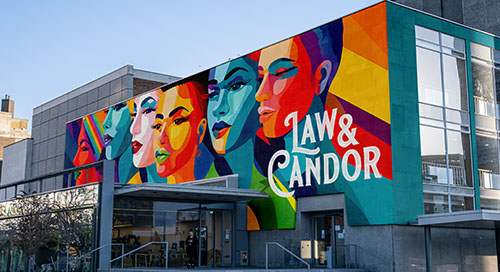
More Than a Seat at the Table: Women Leaders in LegalTech on Gender Equity Part Two
March 9, 2023
|
By:
Building on our conversation from part one, we explore some practical advice and steps for achieving equity, including the role of allies, and how this work will benefit us in the future.
True equity in the workplace starts from the top
While grassroot employee efforts can be impactful, they will never be enough if diversity is not exemplified and valued at the highest levels of an organization. This means that it is not enough for leaders to verbalize a commitment to diversity and inclusion campaigns. Leaders must also back up that commitment with action:
In times of economic volatility, companies can and should continue to devote a portion of their budget to equity and inclusion initiatives, and make sure these initiatives are supported by senior leadership. — Brooke Oppenheimer
When you have leadership at the top that truly values diversity and equity in all its forms— gender diversity, racial diversity, sexual orientation diversity, etc.— that priority will flow down from the leadership to the rest of company. It is incumbent on organizations to ensure their leaders are prioritizing diversity, because the rest of the organization will follow what the leadership is exemplifying. — Ashley Baynham
When you have strong leadership serving in the capacity of championing equity in the workplace on a day-to-day basis, it not only sets a tone and expectation across the organization that diversity is top of mind, but it becomes seamless to follow in their footsteps. —Jeannie E. Farren
This means that, in order to become truly equitable, organizations have a duty to break up inequitable leadership structures.
Historically in corporate America, we have seen an abundance of white, hetero, male leaders in positions of power. It’s hard to think of achieving true equity within the legal industry if that power structure at the top is not diverse. To make that change, it becomes incumbent on those leaders to stand up and say, “I want to lead an organization that doesn’t just resemble me. I want to lead an organization that more strongly resembles this country as whole.” —Michelle Six
Lack of gender diversity in certain roles perpetuates existing biases, leading to inadequate representation in leadership positions. —Brooke Oppenheimer
This duty also applies to individual leaders. Leaders have a responsibility to not only leave the door open for women and other underrepresented groups, but also to proactively help diversify inequitable power structures:
If you are fortunate enough to be trusted to be in a leadership role within your organization, you have an ongoing responsibility to continuously assess how you are applying fairness across the team on a day-to-day basis. Look around your team and make sure that the “shiny” opportunities are being spread evenly across the team and that the women on your team are being provided with the chance to be in the spotlight as often as possible. — Jeannie E. Farren
That idea leads directly to an essential point about the power of allies…
Allies are integral to the fight for gender equity
True gender equity cannot be achieved by women alone. Equity can only be achieved when women and allies come together to support individual women and push for progress, together.
If you are surrounded by people in your (personal and professional) life who share a common goal as important as equity for all, you have already accomplished one of the most difficult hurdles. — Jeannie E. Farren
Because of longstanding historical and systemic gender inequities, our allies are often in a better position within an organization to effect real change. It is therefore imperative that allies remain vigilant, proactive, and unafraid to call out gender biases and inequities when they occur.
As an ally, stay cognizant of some of the ways that unconscious or conscious gender bias can play out in the workplace. For example, if you see someone cutting off a colleague in a meeting, speak up. It becomes very hard to constantly have to champion yourself or work to overcome those gender biases on our own. And for women, there’s always a concern that championing yourself comes off as self-promotion. That’s where a third party may be in a better position to stand up and raise their voice as ally. So, my advice for allies would be: Speak up, in the moment that your voice is needed.” — Ashley Baynham
To help facilitate this, organizations committed to diversity and inclusion can put systems in place that make it easier for individuals and allies to report instances of gender bias when it occurs.
When we witness inequities, we may not stand up because we think that “others” have already raised the issue. But oftentimes, the bystander effect is at play—which leads to no one saying anything at all. This demonstrates the value of having established channels of communication so that people know who they can go to for help. It also shows us that we all have to be comfortable being a little uncomfortable if we want to fight for an equitable workplace for all. —M. Alexandra Billeb
In this way, advocates and allies can create an environment that fosters organizational-wide accountability and responsibility in the fight for gender equity.
Each of us can contribute in ways large and small to ensure that it isn’t just the person with the loudest voice or most senior title who is heard. And we should point out ways in which individuals and organizations are not living up to those principles. It is not enough to say what is important to us. We have to hold each other accountable when we fall short. — M. Alexandra Billeb
Gender equity requires the creation of an inclusive culture that does not tolerate inequity and that supports, champions, and encourages women's contributions. —Brooke Oppenheimer
It is critical to champion equity and inclusion more broadly in order to expand upon gender allies through standing up support groups and creating measurable data points for accountability. — Jeannie E. Farren
This community of advocates and allies, committed to a culture of accountability, has a much better chance at rectifying some of the most challenging and persistent gender equity issues—for example wage inequity:
One of things we can look for from our allies with decision making power is better wage transparency— so that we can more effectively advocate for better wage consistency. One of the biggest barriers to gender equity in the legal profession is unequal compensation. The gender-based wage gap still remains and the legal industry has more work to do in this regard. I believe that greater salary transparency across the legal industry will potentially lead to more wage equity, which is a goal we should all prioritize. — Michelle Six
Conclusion
While there are still significant obstacles ahead, our conversation with these industry leaders demonstrated that by consistently championing equity goals, women and allies can continue the progress that generations of women have made before us towards a more gender equal world.






